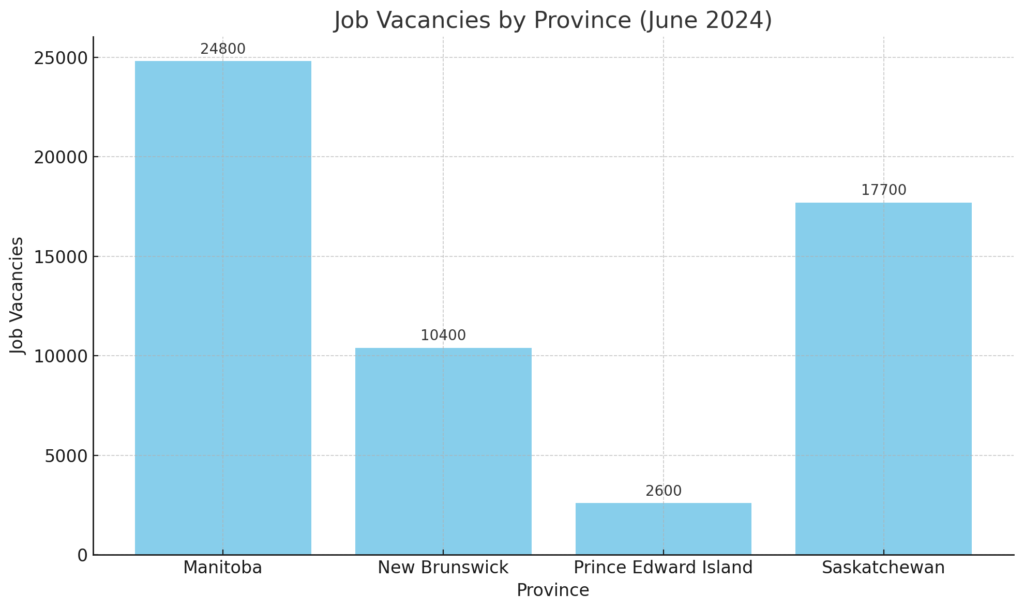The Canadian job market exhibited significant shifts in June 2024, with notable declines in job vacancies across various sectors, signaling potential changes in the country’s labour dynamics. According to the latest data released by Statistics Canada, while some industries remained stable, others saw a marked reduction in job vacancies, raising questions about the broader implications for Canada’s economic health.
One of the most impacted sectors was accommodation and food services, where job vacancies decreased by 7,300 (-10.8%) to 59,900 in June. This figure represents the lowest number of job vacancies in the sector since February 2021, before the COVID-19 vaccines. The year-over-year comparison paints an even starker picture, with vacancies down by 33,100 (-35.6%) compared to June 2023.
The total labour demand in this sector also fell by 8,000 (-0.6%) in June, contributing to a year-over-year decline of 36,500 (-2.6%). The job vacancy rate dropped by 0.5 percentage points to 4.4%, bringing the cumulative decline over the past year to 2.2 percentage points.
Health care and social assistance have now surpassed accommodation and food services as the sector with the highest job vacancy rate, standing at 4.8% in June.
Future reports will be crucial in determining whether these trends are short-term fluctuations or indicative of longer-term shifts in Canada’s job market. For now, the focus remains on understanding and responding to these changes to ensure a balanced and sustainable labour environment across the country.
Job Vacancies and Vacancy Rates by Sector (June 2024)
| Sector | Job Vacancies (June 2024) | Job Vacancies (June 2023) | Year-over-Year Change (%) | Vacancy Rate (June 2024) | Vacancy Rate (June 2023) | Year-over-Year Change in Vacancy Rate (%) |
|---|---|---|---|---|---|---|
| Accommodation and Food Services | 59,900 | 93,000 | -35.6% | 4.4% | 6.6% | -2.2% |
| Transportation and Warehousing | 34,400 | 39,200 | -12.2% | 3.9% | 4.5% | -0.6% |
| Health Care and Social Assistance | 119,500 | 135,000 | -11.5% | 4.8% | 5.9% | -1.1% |
In contrast, the transportation and warehousing sector experienced a modest increase in job vacancies, rising by 3,800 (+12.4%) to 34,400 in June. This increase partially offset the sector’s earlier decline from March to April, where vacancies dropped by 5,200. Despite this short-term gain, the sector still recorded a year-over-year decrease in job vacancies, down by 4,800 (-12.2%) compared to June 2023.
The job vacancy rate in transportation and warehousing stood at 3.9% in June, up by 0.4 percentage points from May but still 0.6 percentage points lower than in June 2023. These fluctuations highlight the sector’s volatility, influenced by various factors such as supply chain disruptions, regulatory changes, and shifts in consumer demand.
While many sectors saw significant changes, the health care and social assistance sector remained relatively stable in June, with job vacancies holding steady at 119,500. This marks the third consecutive month where vacancies in this sector have remained unchanged following a decline in March. The sector continues to account for a substantial portion of all job vacancies in Canada, making up 21.6% of the total in June.
The job vacancy rate in health care and social assistance also remained steady at 4.8%, unchanged from May but down by 1.1 percentage points from June 2023. Despite this slight decrease, the sector now has the highest job vacancy rate of all sectors, surpassing the accommodation and food services industry. This stability may indicate ongoing demand for health care services and the challenges in attracting and retaining qualified professionals in this critical sector.
Job Vacancies by Province (June 2024)
| Province | Job Vacancies (June 2024) | Job Vacancies (June 2023) | Change in Vacancies | Vacancy Rate (June 2024) | Unemployment Rate (June 2024) | Unemployment-to-Job Vacancy Ratio |
|---|---|---|---|---|---|---|
| Manitoba | 24,800 | – | +4,300 | 3.9% | 5.1% | 1.6 |
| New Brunswick | 10,400 | – | +1,800 | – | – | – |
| Prince Edward Island | 2,600 | – | +1,100 | 3.5% | – | – |
| Saskatchewan | 17,700 | – | -2,600 | – | – | – |
| Other Provinces | Stable | – | – | – | – | – |
Provincial data revealed varied trends across Canada. Manitoba, New Brunswick, and Prince Edward Island recorded increases in job vacancies, with Manitoba leading the way with a rise of 4,300 vacancies, bringing the total to 24,800. New Brunswick saw an increase of 1,800 vacancies, reaching 10,400, while Prince Edward Island added 1,100 vacancies, totaling 2,600.
In contrast, Saskatchewan experienced a decrease of 2,600 job vacancies, bringing the total to 17,700. The remaining provinces saw little change in their job vacancy numbers.
Manitoba not only had the highest job vacancy rate in June at 3.9% but also boasted the lowest unemployment rate (5.1%) and the lowest unemployment-to-job vacancy ratio (1.6) among all provinces.

Future reports will be crucial in determining whether these trends are short-term fluctuations or indicative of longer-term shifts in Canada’s job market. For now, the focus remains on understanding and responding to these changes to ensure a balanced and sustainable labour environment across the country.

